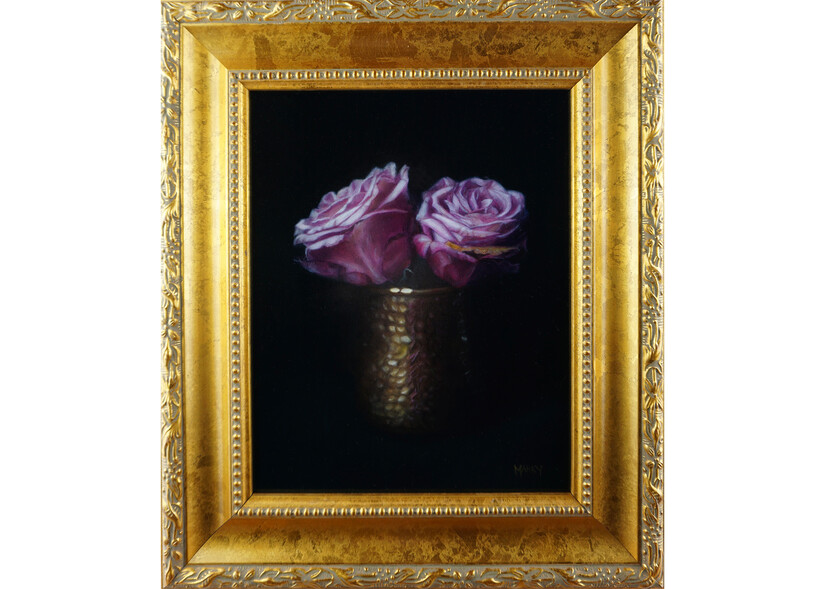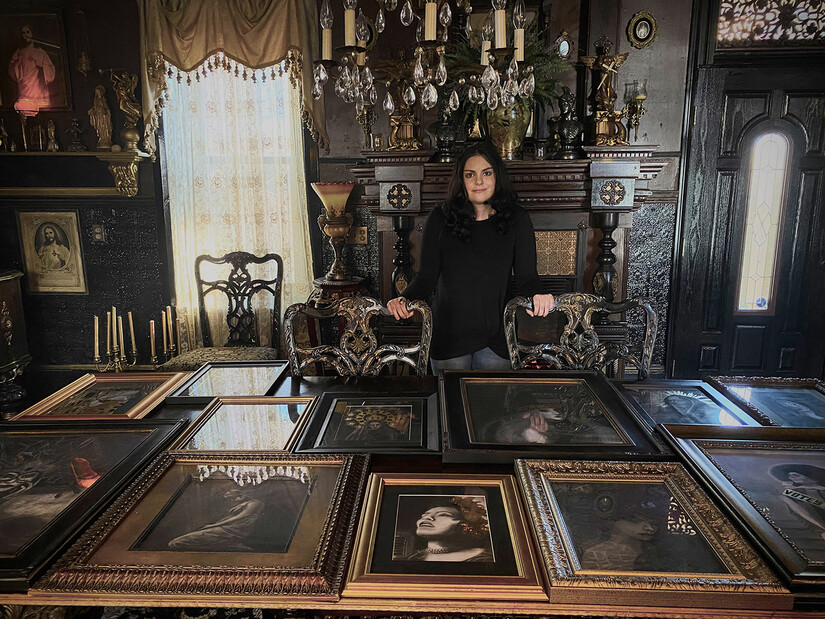Image


Left to right: Marky Barto, Eric Armusik, Nadija Armusik
by Jane Stahl
This article, featuring artist Eric Armusik, includes information and photographs about Marky Barto, an artist who works with him, who will be featured in a "B Inspired" episode available for listening on November 10, 2023, the date of the opening of Marky's solo show at Arts Plus Gallery in West Reading. The exhibit runs throughout November 2023.
Eric Armusik breaks the stereotype often found among artists in his entrepreneurial ability to make a living doing what he loves: making art.
When Eric stopped by Studio B at the end of one of Studio B's exhibits to pick up the artwork of several artists—but none of his own work—I was curious.
He explained that while he is a working professional artist, he was picking up the work of the apprentices who worked with him on his projects and commissions and whom he instructed and advised on developing their artistic talents and forwarding their own art careers.
Always eager to learn how entrepreneurs think and what they do that makes them successful, I’m especially interested in the “business of art” that includes promoting the artists who exhibit at Studio B. I wanted to learn about his apprenticeship program that sounded so “old school,” but, as I learned, is a perfect business model for Eric.
Much like the Old Masters Rembrandt and Reubens, whose apprentices studied and worked under them, one of Eric’s daughters and Marky Barto, a former student, are learning the business of art from him—an artist who has developed a successful 30-year business doing what he loves—making art. Eric adds, “Reubens had 30 apprentices working for him; I admired his business sense.”
“The business of art takes a lot of work,” he explains. “And it’s not just about creating art. At least 50% of my time and effort over the years has been marketing and promoting myself and my work. It’s not easy—especially for artists who are often shy and introverted—because from the very beginning, success means being aggressive in putting yourself ‘out there.’”
“I am supporting a wife and three kids,” he explains, “so I need to work at it.” As an example, he offers: “Coca Cola—biggest name in the world—still must aggressively put themselves, their name, their brand—into the marketplace. Artists need to do the same. Fortunately, it’s so much easier today because of the internet and social media.”
Before the internet, Eric spent time and money making himself known through traditional media, attending shows, participating in gallery exhibits, sending out postcards of his work and where he was exhibiting. “Direct marketing yields perhaps 1% return on the investment; it takes a lot of time and reaches only a handful of people.”
Today, he notes, because of the internet, he can work from anywhere and with social media, marketing and promotion can be done for free. “Spending 10 minutes a day for years ‘getting the word out’ will yield results—not immediately, of course, but eventually. I’m on every social media site there is!”
His artistic journey
Reflecting on his journey as an artist, he recognizes the support he had from both of his parents in his pursuit of an art career. He teases that he felt he had “no choice” in becoming an artist. He recalls drawing as a 3-4-year-old, creating sketches in blank pages in books his parents made available.

Drawing: Nicola Tesla
While he had no formal art lessons, in high school, his entrepreneurial spirit surfaced. He developed a constant flow of business by painting tattoo-like images on his classmates’ jeans jackets that were in style at the time.
Then, surprisingly, he was disappointed in being rejected for acceptance into a college program to study art. He takes some pride today, however, in offering lessons to a number of students from that same college and art professors from around the world.
He departed from his friends after college who went to NYC—hoping to establish themselves there. “But it was a ‘big pond’ they entered. I chose a smaller pond in staying close to home in Berks County although today only 5-10% of my work is local.”
Revenue streams
Over the past 20 years, he’s developed an assortment of revenue streams. He accepts students and commissions from all over the world including the Middle East and China, traveling to complete or deliver them. He has held weeklong workshops for international students; today 80% of his work with students aged 12 to mid-80’s is offered on-line. His students cover a wide range of people and interests including art professors and a retired doctor who just wanted to learn to paint.


Students from Utah and California participate in individual weeklong workshops in 2018 and 2019.
“Everybody is missing something—whether it’s a business goal or something related to a technique in the style of their art. I can often see what they’re missing in the work they show me or in a discussion of how they’ve been promoting their work.
“I give them pragmatic skills,” he offers, “and I have them set goals.” For some, the goal is a technique; for others it’s business—tips on promoting their work, taking complete authority over their work, or their need to develop their own audience—much like becoming a ‘cult band.’ In marketing their work, a personal approach in developing an audience for their work is what’s needed.
“Artists talk about becoming known. There’s recognition and there’s making a living,” he adds. “You can do both, but to make a living, set a goal. Keep it simple. People waste a lot of time on things that aren’t important, that don’t yield results. What’s important is delivering a quality product, creating a niche, and marketing what you’ve got.”
“There’s room for everyone in this business; it’s not a zero-sum game. But participating in shows, hanging in gallery exhibits is OK to start, but it’s not enough to build a brand. And today—with the internet and social media, the game has changed—but it’s work.
Style
Describing himself as a classical figurative artist, his work in oil or charcoal is largely portraits in mythological or religious themes, reminiscent of the Old Masters. His work is commissioned by individuals, churches, or institutions.
Below: Odysseus and the Sirens and Crucifixion of St. Peter


“I had one professor who discouraged me from religious work that’s become my brand. People said I was crazy, but it’s important to me. Sixty to seventy percent of my work is religious.
To help him handle the demand for his commissioned artwork, just like the Old Masters, he invites students to work with him as apprentices—to help him complete his work and to learn from him. He invites students, his apprentices, to work with him on commission pieces. After he develops the composition, they lay the foundation of a piece of work for him to add detail or finish, explaining, “It’s a little like the Tom Sawyer thing.”
Eric’s apprentices are volunteers and unpaid. Benefits include help with their careers, promoting their efforts, sharing their work on his sites, marketing among his collectors, receiving valuable advice from his experience to eliminate time-wasting efforts. Possibly the biggest benefit is the confidence built from taking risks under his guidance and with his support as they work to build their own inventory.
Marky Barto, originally from Czechoslovakia, studied with him for four years and is now an accomplished artist in her own right.






Marky Barto Paintings: "Admirers Gift," "Her Favorite Treat," "Sacred Spirit Arrow," "Springtime Elegance," "Young Boyar of Petrograd:
A portrait entitled "Memories" was awarded “Best in Show” in Studio B’s 2023 “Face” exhibit.

Eric’s daughter Nadija has joined his apprentice program and is finding success developing her signature style under her father’s tutelage.






Nadija's drawings and portraits: "Cleopatra," "Isabella," and "Maenad"
Today, after 30 years in the business of creating art, he finds that helping other artists is his “soft spot” and looks forward to having a brick-and-mortar location for an academy where he can further his work with students in person.
“There’s no nobler cause than helping others. It’s personal to me. I am happiest sharing tips and answering questions.” Helpful includes creating time lapse videos of his process. “People can see what I do and how I do it. It’s a little thing, but helpful. My goal is to build a reputation of being helpful.”
Future
In the meanwhile, Eric set a goal of creating 40 large panels—4’x5’—illustrating Dante’s Inferno. His intent was to complete the project by 2018. Today, he has completed 15 panels.

Dante's Inferno Canto 4

Dante's Inferno Canto 9: Celestial Messenger
Eric composes the artwork. To ensure accuracy and legitimacy of Dante’s intent, he has hired a professor of Medieval Literature to examine his initial sketches and provide feedback and guidance. Models are hired; the painting begins. The apprentices paint some of the layers; Eric completes each piece.
In funding the project, he has sold some of the panels. The end goal is to bring all 40 panels together for an exhibit to be staged in a museum in Florence, Italy. He expects the exhibit will travel and, he hopes, be utilized as a college text as part of his legacy.

In asking him to share what he does, what he's learned, and how he has managed to achieve success, I hoped other artists would benefit and help him to break the age-old stereotype of “starving artist.”
A dear friend of mine and fellow English teacher always wondered if we’d be smart enough to include poets on our spaceships. For their unique perspectives. For their creativity and entertainment. We need poets—artists of all kinds—on our spaceships; there’s no reason they need to be hungry.